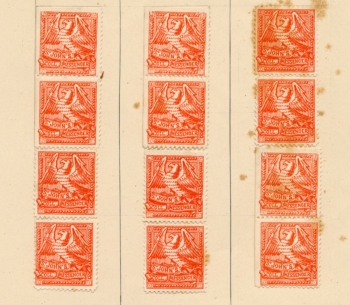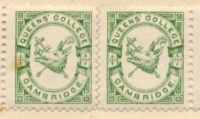The stamps of St John's College
The concept of the College stamp was introduced by Keble College, Oxford, when the College opened in 1871. Due to its financial situation it was decided that instead of placing charges for deliveries onto members' accounts, to be paid at the end of each term, individuals would pay for a stamp at the time of delivery. The idea proved successful, and spread to several other Oxford colleges before reaching Cambridge at Selwyn College in 1882.
St John's College introduced its stamp in 1884, selling it in the Butteries at a half-penny each or fivepence per dozen. Each item required one stamp, with those too big to fit in the Message-boxes requiring four. The Message-boxes were located in the Front Gate and New Court Porter's Lodges and were cleared three times each day (except on Sundays, and at various periods out of term). The Messenger had a different delivery circuit depending on the time of day, covering many streets in the city centre and all the Colleges except Cavendish College (which stood on the site now occupied by Homerton College), Ridley Hall, Selwyn, Newnham and Girton Colleges.
 |
St John's College Messenger stamps |
| Queens' College stamps |  |
In 1886 Lord John Manners, the then Postmaster-General, complained to the local authorities stating "that the exclusive privilege of carrying letters by post was deliberately conferred upon the Postmaster-General, and that he felt bound to maintain that privilege intact". He particularly objected to the Colleges’ use of stamps, and somewhat surprisingly when officials from the University of Oxford met a month later they decided to succumb to his demands. From this point on it appeared that the Post Office was particularly anxious to prove that it could make deliveries quickly, with a Cambridge Post Office 'Special Notice' announcing its new arrangements in 1887:
The public will have the means of frequently communicating by letter with correspondents in different parts of Cambridge. For example, a letter posted at 2 am may be replied to by the 8.40 am Collection, and the reply delivered in any part of the Town between 10 am and 12 noon. A rejoinder can be posted by the 1.25 pm Collection and delivered between 2.30 pm and 4.30 pm, and that rejoinder may be replied to by the 6.25 pm Collection, and the reply delivered between 7.30 pm and 9.30 pm.
Bibliography:
Lister, Raymond. (1966). College stamps of Oxford and Cambridge. Cambridge: The Golden Head Press Ltd.
Miller, Edward. (1961). Portrait of a College. A history of the College of Saint John the Evangelist in Cambridge. Cambridge: Cambridge University Press.
This Special Collections Spotlight article was contributed on 14 May 2013 by Rachel Walker, Library Projects Assistant (Maternity Cover).